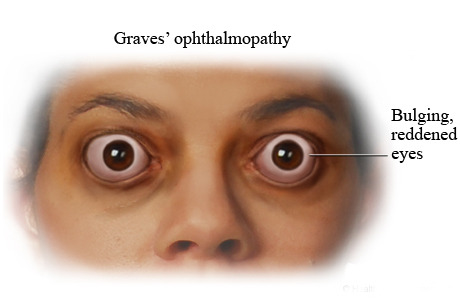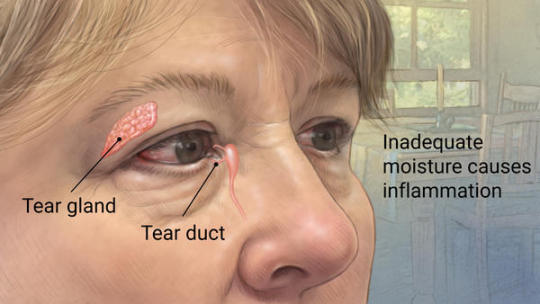#preptosis
Text
Dry Eye Disease
Signs and symptoms, which usually affect both eyes, may include:
A stinging, burning or scratchy sensation in your eyes
Stringy mucus in or around your eyes
Sensitivity to light
Eye redness
A sensation of having something in your eyes
Difficulty wearing contact lenses
Difficulty with nighttime driving
Watery eyes, which is the body's response to the irritation of dry eyes
Blurred vision or eye fatigue.
Dry eyes syndrome are caused by a lack of adequate tears. Your tears are a complex mixture of water, fatty oils and mucus. This mixture helps make the surface of your eyes smooth and clear, and it helps protect your eyes from infection.For some people, the cause of dry eyes is decreased tear production. For others it's increased tear evaporation and an imbalance in the makeup of your tears
0 notes
Text
Thyroid Eye Disease (TED or Graves Eye Disease)
Graves' eye disease, also known as thyroid eye disease, is an autoimmune condition in which immune cells attack the thyroid gland which responds by secreting an excess amount of thyroid hormone. As a result, the thyroid gland enlarges and excess hormones increase metabolism. The hypermetabolic state is characterized by fast pulse/heartbeat, palpitations, profuse sweating, high blood pressure, irritability, fatigue, weight loss, heat intolerance, and loss of hair and alterations in hair quality. When the immune system attacks the tissues around the eyes, it causes the eye muscles or fat to expand.
The eyes are particularly vulnerable to Graves' eye disease, because the autoimmune attack often targets the eye muscles and connective tissue within the eye socket. This likely occurs because these tissues contain proteins that appear similar to the immune system as those of the thyroid gland. Ocular symptoms can range from mild to severe; but only 10-20% of patients have sight threatening disease. Another tissue that can also be involved in the immune attack of Graves' eye disease is the skin of the shins.
0 notes
Text
Eyes, Bulging
Bulging or protruding of one or both eyes is called proptosis or exophthalmos. Exophthalmos is usually used when describing bulging eyes caused by Graves disease, a disorder causing overactivity of the thyroid gland (hyperthyroidism). Bulging eyes are not the same as prominent eyes. Some disorders that may change the appearance of the face and eyes but that do not cause true eye bulging include Cushing disease and severe obesity.
Bulging sometimes causes other symptoms. The eyes may be dry and irritated (which causes watering) because the bulging may prevent the eyelids from closing properly. Also, people may blink less often or may appear to stare. Depending on the cause of bulging, people may have other symptoms such as double vision or difficulty focusing on objects. If bulging is prolonged, the optic nerve is stretched, which may impair vision. Vision may also be impaired if the disorder causing bulging also presses on the optic nerve.
Causes
The most common cause in adults is Graves disease, which causes swelling of tissue behind and around the eye, pushing the eyeball forward. In children, the most common cause is infection.
Other causes are uncommon. They include tumors, bleeding, infections (in adults), and, rarely, inflammation of structures within the orbit without infection (called orbital pseudotumor). Glaucoma that is present from birth (primary infantile glaucoma) can cause the eyes to enlarge, which may seem to look similar to eyes that are pushed forward.
0 notes
Photo

The thyroid gland is located at the bottom-most part of the neck and is a very important part because of its metabolism regulation. This gland is responsible for the production of two important hormones and a lot of people suffer from either hyperthyroidism or hypothyroidism.
0 notes
Text
Treating dry eye syndrome
Treatment for dry eye syndrome helps to control the symptoms, but there's no cure. Some people may have recurring episodes for the rest of their lives.
The exact treatment for dry eye syndrome depends on whether symptoms are caused by:
decreased production of tears
tears that evaporate too quickly
an underlying condition
The first thing to consider is whether there are any obvious factors, such as a medication, causing the symptoms.

If your dry eye syndrome is caused by an underlying condition, your GP can prescribe treatment or refer you to an appropriate specialist.
You may also be able to help prevent dry eye syndrome or ease your symptoms by adjusting your environment, keeping your eyes clean, and improving your diet.
0 notes
Text
Tumours of the uveal tract
Melanoma
Uveal melanomas have an incidence of 6 per million per year. Most are choroidal, with the remainder arising from the iris and ciliary body. The melanoma arises in the pigmented uveal tract (the middle layer of the eye, between the sclera and the retina).
Choroidal melanoma
This is the most comon site - it is the most common primary intraocular malignant tumour. See separate Choroidal Melanoma article.
Iris melano
5% of uveal melanomas. Iris melanoma is the least common site of primary uveal melanoma but it has the best prognosis. It is three times more common in blue/grey irides and rare in people of Afro-Caribbean ethnicity. Predisposing conditions include dysplastic cutaneous naevi, familial melanoma and neurofibromatosis. The increased iris pigmentation associated with latanoprostdoes not appear to be a risk facto
0 notes
Photo

The thyroid gland is located at the bottom-most part of the neck and is a very important part because of its metabolism regulation. This gland is responsible for the production of two important hormones and a lot of people suffer from either hyperthyroidism or hypothyroidism
0 notes
Text
Bulging Eyes
What Causes Bulging Eyes?
Bulging eyes have been linked to a number of diseases and conditions, including glaucoma, hyperthyroidism, leukemia, and more.
The most common cause of bulging eyes is Graves’ disease, or more specifically, Graves’ ophthalmopathy – an autoimmune condition where the thyroid gland mistakenly senses harmful cells and releases antibodies, which then fuse to eye muscles and cause inflammation.
Symptoms of Bulging Eyes
Bulging eyes are usually a symptom of another condition. Symptoms of Bulging eyes may include
Appearance of protruding eyes
Excessive dryness in eyes
Visible whiteness between the top of the iris and the eyelid
Eye pain
Eye redness
Treatment for Bulging Eyes
The underlying cause of bulging eyes will determine the overall course of treatment. However, in all cases, bulging eyes will be exposed to more air making it difficult to keep them lubricated. To combat excessive dryness, artificial tears and eye drops can be used for moisture and lubrication.
0 notes
Text
Preptosis
Proptosis alludes to forward bulge of the globe as for the circle. There are many reasons for proptosis which can be isolated by area and it merits recollecting that it is not quite recently orbital malady forms that cause proptosis.
Wording
Exophthalmos additionally depicts forward projection of the globe. A few creators utilize the terms in an unexpected way, which can confound:
proptosis and exophthalmos are regularly utilized conversely
exophthalmos used to allude to serious (>18 mm) proptosis
exophthalmos used to allude to endocrine-related proptosis
Enophthalmos is the inverse, dislodging of the globe posteriorly.
0 notes